Ronald Mulwa
This study aims at conducting an intensive bird survey in the little known and isolated hilltop forests of Mutha, Endau, Nuu, Muumoni Hills in Kitui and Mwingi districts of eastern Kenya.

African Paradise Flycatcher.
Many hilltop forest ecosystems are faced with high risk of habitat degradation and biodiversity loss despite their importance as water catchments for the local communities. This is largely due to unsustainable resource utilisation e.g. encroachment and charcoal burning by poor rural communities given the increasing human population. This study aims at conducting an intensive bird survey in the little known and isolated hilltop forests of Mutha, Endau, Nuu, Muumoni Hills in Kitui and Mwingi districts of eastern Kenya. The need for this study was motivated by the observation that many isolated hilltop forest ecosystems are rich in endemic species of biodiversity. Recent plant collections in some of these hills have revealed a new species to science and rediscovery of an endemic thought to be extinct.
Various standard methods will be used to survey birds at different habitat types and altitude levels at all sites. Understorey birds will be sampling using mist-netting, while Times Species Counts (TSCs) will be used to assess the relative species abundance (Pomeroy 1992). Line transects will be used to estimate densities according to Distance Sampling (Buckland et. al. 1993). Species diversity indices (H') will be determined for species at each site (Zar 1984). Vegetation parameters will be estimated in 10m by 10m quadrants along the transects to enable specific correlation with bird species abundance and comparisons between sites. Data will be collected in all the four compass directions around the hills and the top. Similar effort will be applied for each forest to enable meaningful comparisons. During the surveys the current and potential threats on birds and biodiversity of these forests will be documented.
Eastern Kenya has been highly marginalized in terms of biodiversity research compared to other districts, therefore the local communities here have had no opportunity to understand or participate in conservation. The project will involve members of the local community as field assistants and build local capacity for bird identification, enhance awareness creation and community participation in conservation activities. The information gathered here will be used as baseline to initiate monitoring schemes for species and habitats. The project will work very closely with the Kenya’s Forest Department and Nature Kenya, the Birdlife Partner in Kenya to ensure advocacy and information disseminated to national policy makers. Overall this project will help foster the legal protection of these forests, attract researchers and promote ecotourism activities with benefits to the local communities.